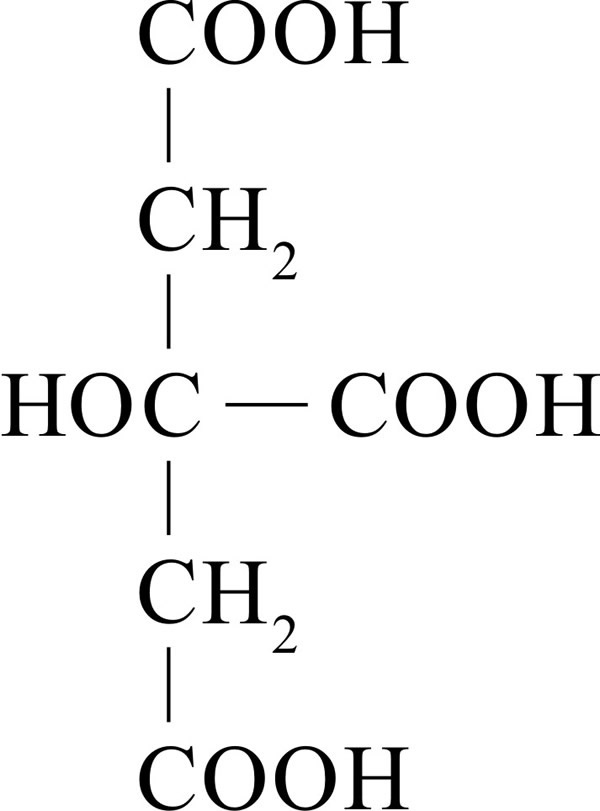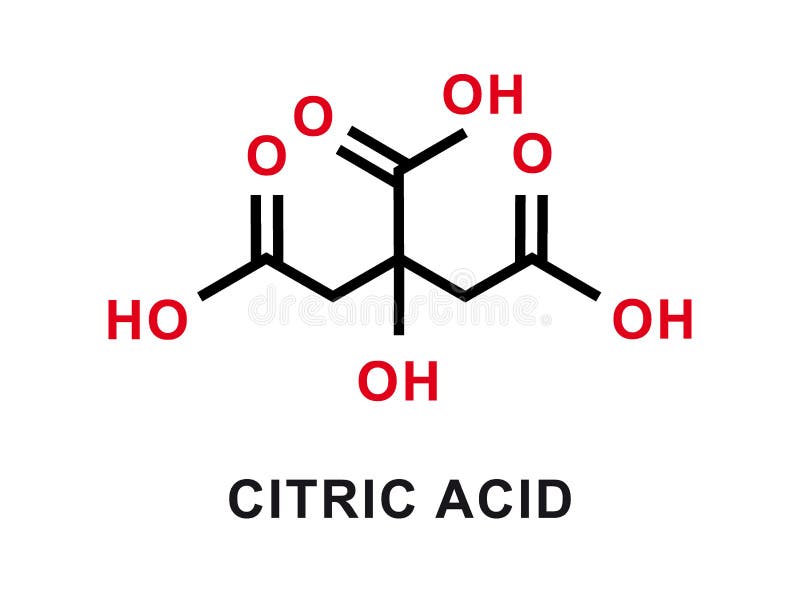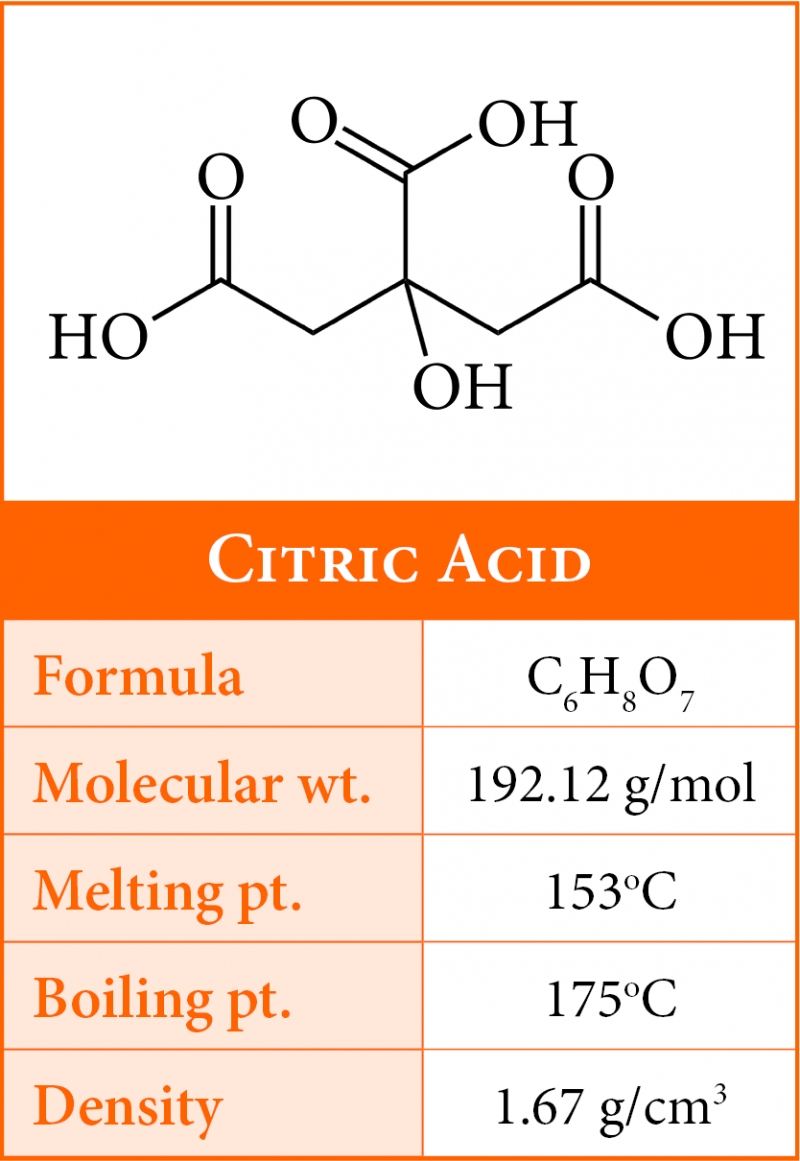
3D image of Citric acid skeletal formula molecular chemical structure of C6H8O7 isolated on
Sodium citrate is the sodium salt of citric acid. It is white, crystalline powder or white, granular crystals, slightly deliquescent in moist air, freely soluble in water, practically insoluble in alcohol. Like citric acid, it has a sour taste. From the medical point of view, it is used as alkalinizing agent.

17.14 Citric acid biotechnology
A study of abdominal pain and severity of other side effects attributed to Picolax, a combination of citric acid, magnesium oxide and sodium picosulfate, was conducted among 267 patients, 55 of whom had inflammatory bowel disease, all of whom were given a full single dose of Picolax as preparation for radiology or endoscopy. The frequency of increased abdominal pain and severe side effects.
Citric Acid Ionic or Covalent
Citric acid. Molecular Formula CHO. Average mass 192.124 Da. Monoisotopic mass 192.027008 Da. ChemSpider ID 305.

Fórmula química Ácido cítrico Molécula Composto químico Química, outros, elemento químico
29.7 • The Citric Acid Cycle The initial stages of catabolism result in the conversion of both fats and carbohydrates into acetyl groups that are bonded through a thioester link to coenzyme A. Acetyl CoA then enters the next stage of catabolism—the citric acid cycle, also called the tricarboxylic acid (TCA) cycle, or Krebs cycle, after Hans Krebs, who unraveled its complexities in 1937.
Citric Acid Concept Chemical Formula Icon Label, Text Font Vector Illustration Stock Vector
The citric acid cycle is a closed loop; the last part of the pathway reforms the molecule used in the first step. The cycle includes eight major steps. Simplified diagram of the citric acid cycle. First, acetyl CoA combines with oxaloacetate, a four-carbon molecule, losing the CoA group and forming the six-carbon molecule citrate.

Handwriting Chemical Formula of Citric Acid Stock Image Image of molecular, black 155597461
Chemical degumming involves the liberation of PA from its salts with an acid that is stronger than PA itself. The degumming acid is either phosphoric acid, which forms a precipitate with Ca and Mg, or citric acid, which forms a complex of Ca and Mg. Alternatively, a salt of ethylene diamine tetraacetic acid (EDTA) can be used as a chelating.

Citric Acid Chemical Formula Stock Vector Illustration of chemistry, chemical 155833906
Asam sitrat (Belanda: citroenzuur, secara harfiah "asam sitrun"; bahasa Inggris: citric acid) merupakan asam organik lemah dengan rumus kimia HOC(CO 2 H)(CH 2 CO 2 H) 2 yang ditemukan pada daun dan buah tumbuhan genus Citrus (jeruk-jerukan). Senyawa ini merupakan bahan pengawet yang baik dan alami, selain digunakan sebagai penambah rasa masam pada makanan dan minuman ringan.

Citric Acid Molecule, is Found in Citrus Fruits, Lemons and Limes. is Used As Additive in Food
Citric acid is an organic compound naturally found in citrus fruits. Manufactured citric acid, created from a type of black mold, is one of the most common additives in the world. It is found in everything from foods to dietary supplements and cleaning agents. Though citric acid is considered safe, it may trigger a reaction in those with allergies.

Citric Acid Chemical Formula. Citric Acid Chemical Molecular Structure. Vector Illustration
Butylated hydroxytoluene (BHT), also known as dibutylhydroxytoluene, is a lipophilic organic compound, chemically a derivative of phenol, that is useful for its antioxidant properties. BHT is widely used to prevent free radical-mediated oxidation in fluids (e.g. fuels, oils) and other materials, and the regulations overseen by the U.S. F.D.A.—which considers BHT to be "generally recognized.

Citric Acid
Modify: 2024-03-02. Description. Zinc citrate is a zinc salt of citric acid. It is available as dietary supplements as a treatment of zinc deficiency and source of zinc, which is an essential trace element. Zinc citrate demonstrates effective absorption following oral administration. DrugBank.

Citric acid » Cosmética em Foco
Citric acid monohydrate is an organic molecular entity. ChEBI. Citric Acid Monohydrate is a tricarboxylic acid found in citrus fruits. Citric acid is used as an excipient in pharmaceutical preparations due to its antioxidant properties. It maintains stability of active ingredients and is used as a preservative.

Detailed Illustration of the Molecule of Citric Acid Stock Vector Illustration of background
Citric acid (2-hydroxy-1,2,3 propanetricarboxylic acid, C6 H 8 O 7) ( Figure 1) is a white or colorless, odorless, crystalline solid. It is highly soluble in water, freely soluble in ethanol, and slightly soluble in ether. Citric acid has three carboxyl groups and, therefore, is a good buffer for pH control. Figure 1.

Citric acid hires stock photography and images Alamy
citric acid, a colourless crystalline organic compound belonging to the family of carboxylic acids, present in practically all plants and in many animal tissues and fluids. It is one of a series of compounds involved in the physiological oxidation of fats, proteins, and carbohydrates to carbon dioxide and water ( see tricarboxylic acid cycle ).

Citric acid (food additive E330) 3D molecular model Stock Photo Alamy
Ini adalah daftar senyawa kimia yang umum, disertai rumus kimia dan nomor CAS, dan diindeks berdasarkan rumus kimia.. citric acid: 77-92-9 C 6 H 9 N 3 O 2: histidine His: 71-00-1 ethyl 5-amino-1H-pyrazole-4-carboxylate: 6994-25-8 C 6 H 9 N 3 O 3: metronidazole: 443-48-1 C 6 H 10 O 3: 4-acetylbutyric acid:

Citric Acid Blog Structure and Polarity
Disodium pyrophosphate or sodium acid pyrophosphate (SAPP) is an inorganic compound with the chemical formula Na 2 H 2 P 2 O 7.It consists of sodium cations (Na +) and dihydrogen pyrophosphate anions (H 2 P 2 O 2− 7).It is a white, water-soluble solid that serves as a buffering and chelating agent, with many applications in the food industry.When crystallized from water, it forms a.

Citric acid cycle Wikipedia
Citric acid is a weak tricarboxylic acid found in citrus fruits like lemons, which contain 7-9% citric acid according to their dry weight. The three carboxylate groups of citric acid monohydrate have different pKa values, namely 3.15, 4.78, and 6.40 [ 7 ]. Until 1919, lemons were the main source of citric acid ( Figure 1 ).